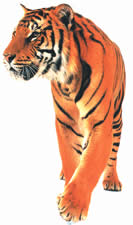
Dimdima
Online Children's Magazine from India

Dimdima
Online Children's Magazine from India

One of the world’s largest censuses of tigers kicked off from Saznekhali tiger reserve, 75 km south of Kolkata on 14 January. Hundreds of forest guards and volunteers equipped with protective fibreglass vests, firecrackers, nylon nets and rifles began scouring the swampy mangrove forest in the Sunderbans delta to determine the number of the cats. India has the world’s largest tiger population. The 9000-sq-km Sunderbans, which falls partly in India and partly in Bangladesh, is home to the largest numbers of tigers in a single region anywhere in the world. The UNESCO has declared it a World Natural Heritage Site.
A census of animals is not an easy task. For one, it is difficult to identify individuals of the same species and secondly, the animals are always on the move.
Although a tiger can be identified by its pattern of stripes and facial markings it is not practicable to go around counting tigers in this way and in order to take a fairly accurate census of the tiger various methods are employed which include recording of all sightings of the animal, its kills, its tracks and its defecations.
Tigers have fixed habits and each individual has a well-defined territory. But during the summer when water becomes scarce, several tigers may use the same pool and then a physical count of the tigers in a particular area becomes possible. In order to avoid counting the same tiger twice, the left hind pugmark of each tiger track is traced on a piece of framed ground glass. Pugmarks of females are tapering and triangular, whereas those of males are squarer. To a trained tracker, pugmarks are as revealing as fingerprints are to a forensic expert. When a tiger that is being observed has gone, its pugmarks are checked out with the pugmark records to make sure that the animal has not been counted earlier. Another aid to tiger identification is its roar. Each tiger has a distinctive roar and a record is made of all such vocalizations.
India had a tiger population of around 40,000 at the turn of the millennium. Today there are only a little over 3,500 of the animals left.
Data from the 2004 census will be used for a biodiversity project to study the breeding and feeding habits of Bengal tigers. The project will be funded by the United Nations.
The census was conducted jointly with Bangladesh. Tigers frequently cross over to Bangladesh and vice-versa, in search of fresh water which sometimes leads to one animal being counted twice!
Last updated on :9/28/2004
EXPLORE MORE...
COMMENT ON THIS ARTICLE
Wants to share something related to this article? Please use the form below.
Dimdima is the Sanskrit word for ‘drumbeat’. In olden days, victory in battle was heralded by the beat of drums or any important news to be conveyed to the people used to be accompanied with drumbeats.
Bharatiya Vidya Bhavan
K. M Munshi Marg,
Chowpatty, Mumbai - 400 007
email : editor@dimdima.com
Bharatiya Vidya Bhavan
505, Sane Guruji Marg,
Tardeo, Mumbai - 400 034
email : promo@dimdima.com
Dimdima.com, the Children's Website of Bharatiya Vidya Bhavan launched in 2000 and came out with a Printed version of Dimdima Magazine in 2004. At present the Printed Version have more than 35,000 subscribers from India and Abroad.